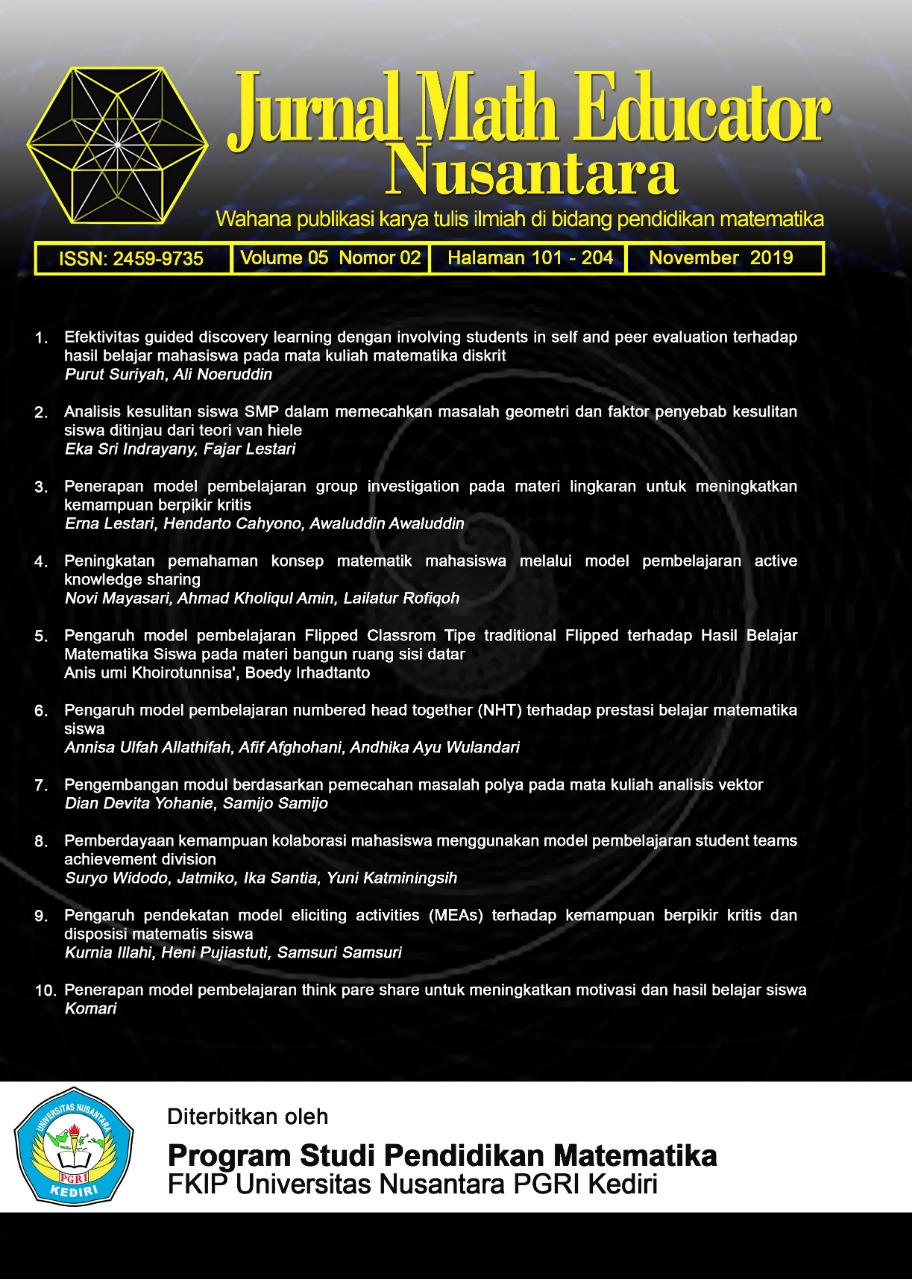Efektivitas guided discovery learning dengan involving students in self and peer evaluation terhadap hasil belajar mahasiswa pada mata kuliah matematika diskrit
DOI:
https://doi.org/10.29407/jmen.v5i2.13515Keywords:
guided discovery learning, involving students in self, peer evaluationAbstract
Abstrak: Tujuan penelitian ini untuk membuktikan apakah guided discovery learning dengan involving students in self and peer evaluation lebih efektif dibandingkan dengan model pembelajaran langsung terhadap hasil belajar mahasiswa semester IV Program Studi Pendidikan Matematika. Desain posttest only control dilaksanakan pada mata kuliah matematika diskrit di IKIP PGRI Bojonegoro tahun akademik 2018/2019. Penelitian ini menggunakan teknik sampling jenuh dimana semua anggota populasi dijadikan sebagai sampel. Teknik pengumpulan data dalam penelitian ini menggunakan teknik dokumentasi dan tes. Uji hipotesis menggunakan t-test. Hasil dari analisis data diperoleh uji hipotesis pada kelas eksperimen dan kontrol diperoleh thitung= 3,2707553 dengan ttabel = 1,99084707. Karena thitung > ttabel maka H0 ditolak sehingga dapat disimpulkan bahwa hasil belajar mahasiswa semester IV Program Studi Pendidikan Matematika IKIP PGRI Bojonegoro yang dikenai pembelajaran guided discovery learning dengan involving students in self and peer evaluation lebih efektif daripada yang dikenai pembelajaran langsung.
References
Balim, A. G. (2009). The Effects of Discovery Learning on Students’ Success and Inquiry Learning Skills. Eurasian Journal of Educational Research, Issue 35, 1-20.
Budiyono. (2009). Statistika untuk Penelitian. Surakarta: UNS Press
Chambers, D., Thiekotter, A., & Chambers, L. (2013). Preparing Student Nurses for Contemporery Practice: The Case for Discovery Learning. Journal of Nursing Education and Practice, 9 (3), 106-113.
Effiong, U. M. (2010). Effect of Guided-Discovery, Student-Centred Demonstration and the Expository Instructional Strategies on Students’ Performance in Chemistry. Indexed African Journals, 4 (4), 389-398.
Furner, J. M., & Marinas, C.A. (2007). Geometry Sketching Software for Elementary Children: Easy as 1, 2, 3. Eurasia Journal of Mathematics, Science, & Technology Education, 3(1), 83-91.
Puspananda, D., & Suriyah, P. (2017). Efektivitas Pembelajaran Laboraturium Dengan Involving Students In Self-And Peer Evaluation Ditinjau Dari Gaya Kognitif Pada Mahasiswa Pendidikan Matematika. Jurnal Math Educator Nusantara: Wahana Publikasi Karya Tulis Ilmiah Di Bidang Pendidikan Matematika, 3(2), 83 – 94. doi:10.29407/jmen.v3i2.11800
Salman, M. F. (2009). Active Learning Techniques (ALT) in A Mathematics Workshop; Nigerian Primary School Teachers’ Assesment. International Electric Journal of Mathematics Education, 1(4), 23-35.
Suprihatiningrum, J. (2013). Strategi Pembelajaran Teori dan Aplikasi. Jogjakarta: Ar-Ruzz Media.
Suriyah, P., Kusmayadi, T., & Usodo, B. (2015). Eksperimentasi Model Pembelajaraan Kooperatif STAD with Guided Discovery Learning pada Materi Pokok Lingkaran ditinjau dari Adversity Quotient. Jurnal Pembelajaran Matematika, 3(3), 256-267.
Widodo & Lusi, W. (2013). Peningkatan Aktivitas Belajar dan Hasil Belajar Siswa dengan Metode Problem Based Learning. Jurnal Fisika Indonesia, 49(17). ISSN 1410-2994.
Zakaria, E., & Iksan, Z. (2007). Promoting Cooperative Learning in Science and Mathematics Education: A Malaysian Perspective. Eurasia Journal of Mathematics, Science & Technology/ Education, 3 (1), 35-39.
Downloads
Published
Issue
Section
License
Authors who publish with this journal agree to the following terms:
- Copyright on any article is retained by the author(s).
- The author grants the journal, the right of first publication with the work simultaneously licensed under a Creative Commons Attribution License that allows others to share the work with an acknowledgment of the work’s authorship and initial publication in this journal.
- Authors are able to enter into separate, additional contractual arrangements for the non-exclusive distribution of the journal’s published version of the work (e.g., post it to an institutional repository or publish it in a book), with an acknowledgment of its initial publication in this journal.
- Authors are permitted and encouraged to post their work online (e.g., in institutional repositories or on their website) prior to and during the submission process, as it can lead to productive exchanges, as well as earlier and greater citation of published work.
- The article and any associated published material is distributed under the Creative Commons Attribution-ShareAlike 4.0 International License
















